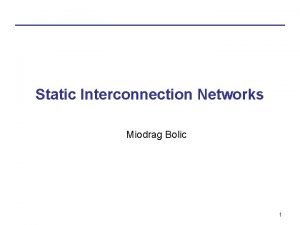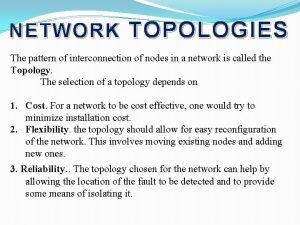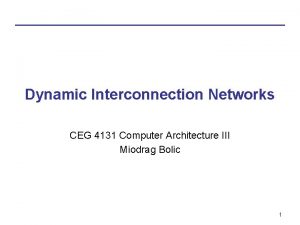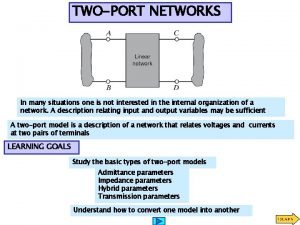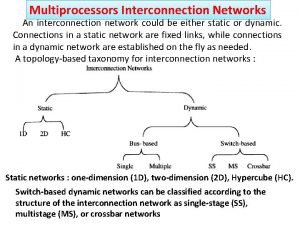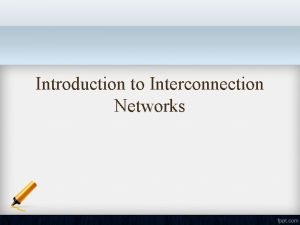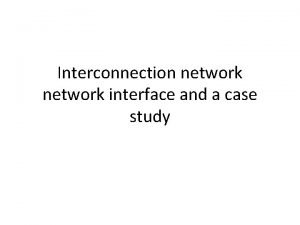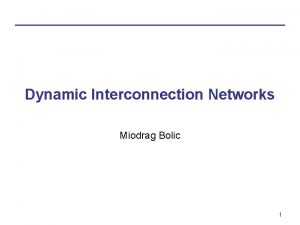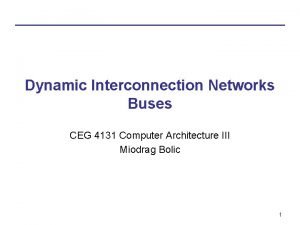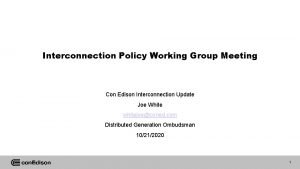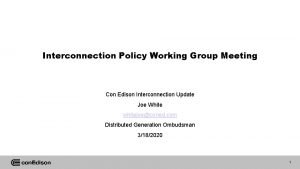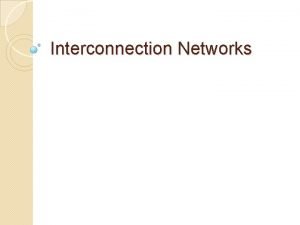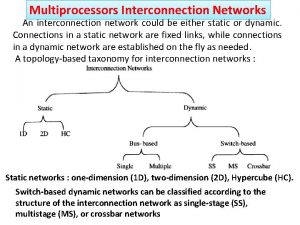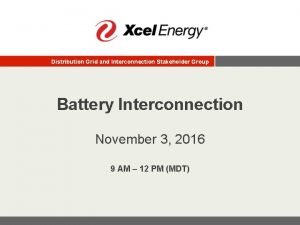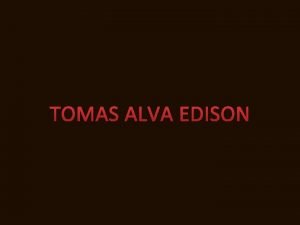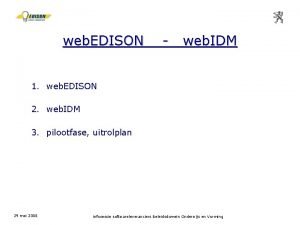Interconnection Technical Working Group Meeting Con Edison Network











- Slides: 11

Interconnection Technical Working Group Meeting Con Edison Network Screening Questions 6/26/2019 DRAFT PROPOSAL 1

Interconnection Policy Working Group Meeting Agenda • Background & Timeline • Review of Proposed Network Screens • Sub-team meeting and IPWG Stakeholder Engagement DRAFT PROPOSAL 2

Background & Timeline • 2018 Screen A 1 Introduction & Review • January 2019 IPWG Presentation/Review • Con Edison Sub-Committee Team Lead – Beatrice Troiano – – January 2019 – May 2019 Internal Cross-Functional Committee Formation and Draft Screens Development June 2019 – Interconnection Technical, Policy & Joint Utility Working Group Introduction to Network Screens June 2019 – August 2019 Stakeholder Feedback September 2019 – Network Screens Finalization DRAFT PROPOSAL 3

Screen A: Is the PCC on a Networked Secondary System? • Does the proposed system connect to a secondary network system? – Yes (Proceed to Network Screen Questions) – No (Proceed to traditional Preliminary Screen • This screening question determines if the project is interconnecting on the network or non-network system. • Due to reverse power relaying and control impacts, network projects should be reviewed and mitigated via the screening process. Questions) DRAFT PROPOSAL 4

Screen B: Is UL certified equipment being installed? • Does the applicant propose to use equipment that has been listed to meet UL 1741 (Inverters, converters and charge controllers for use in independent power systems) and for inverter based equipment, UL 1741 and its supplement SA, by a nationally recognized testing laboratory? • This screening question tests the possibility for islanding. UL certified equipment has anti-islanding capabilities. • A failed screen result indicates the project is not using UL 1741 certified equipment and creates an impact that has to be mitigated through a CESIR study or additional analysis. – Yes (Pass Screen) – No (Fail Screen) DRAFT PROPOSAL 5

Screen 1: Is the existing service, transformer and network protector(s) adequate? • Is the existing service, transformer (transformer • This screening question tests for thermal overloads closest to point of interconnection) and network related to the existing, nearest transformer and protector(s) adequate to interconnect the service. aggregate and proposed DER capacity (including • A failed screen result indicates that the transformer this project)? (transformer closest to point of interconnection) – Yes (Pass Screen) – No (Fail Screen) and/or service should be upgraded to allow interconnection of this project. The percentage overload of existing infrastructure is listed in the failed response to assist the developer in understanding the magnitude of the failure. Failure Responses: – Data not available to perform this screen. Project will require a CESIR study for interconnection. – – Network protectors require upgrade. – The proposed interconnection exceeds the existing transformer nameplate by xyz%. The proposed interconnection exceeds the existing cable ampacity by XYZ Amps. • Developers may often opt to decrease the size of the DG at this location during the Preliminary Screening Analysis Meeting to Pass this screen if identified. DRAFT PROPOSAL 6

Screen 2: Is the DG system proposed compatible with the utility grid? • 2. 1 Identify the equipment type (Inverter, Synchronous or Induction) and size (k. W) – Yes (Pass Screen) – No (Fail Screen) Failure Responses: – Network protectors do not allow for reverse power flow. The project will require a CESIR study for interconnection. – The proposed (insert equipment type and size) DG system requesting interconnection to the secondary network system requires further review. – * When a CHP project, this verbiage is also produced the project requires review of control and relay program operations. • This screening question tests for grid concerns based upon the technology being installed. • A failed screen result indicates further review is required to identify adequate protection and control of the DER project (if a CHP project) or the DER’s impact to the grid has to be reviewed in detail through a CESIR study or additional analysis. DRAFT PROPOSAL 7

Screen 2: Is the DG system proposed compatible with the utility grid? • 2. 2 Can the network protector(s) accommodate • reverse power? – Yes (Pass Screen) – No (Fail Screen) • Failure Responses: – Network protectors do not allow for reverse power flow. The project will require a CESIR study for interconnection. – The proposed (insert equipment type and size) DG system requesting interconnection to the secondary network system requires further review. – * When a CHP project, this verbiage is also produced the project requires review of control and relay program operations. This screening question tests for grid concerns based upon the technology being installed. A failed screen result indicates further review is required to identify adequate protection and control of the DER project (if a CHP project) or the DER’s impact to the grid has to be reviewed in detail through a CESIR study or additional analysis. DRAFT PROPOSAL 8

Screen 3: Simplified Penetration Test • 3. 1 Is the aggregate interconnected and proposed DER capacity (including this project) less than 15% of the minimum load of the network? Failure Responses: – Data not available to perform this screen. The project will require a CESIR study for interconnection. – Aggregate interconnected and proposed DER (including this project) in the network is XX% of the minimum load. • This screening question evaluates the amount of DER penetration in the area. • The minimum load of the network compared to the interconnected and queued distributed generation is used to study the effects of voltage rise and network protector operations. • Evaluation of potential voltage/backfeed impacts on the system is performed. • A failed screen results indicates further review of voltage rise, thermal loading and backfeeding is required to identify adequate protection and upgrades to allow interconnection of this project. DRAFT PROPOSAL 9

Screen 3: Simplified Penetration Test – Failure results • 3. 2 Is the ratio of the aggregate interconnected • This screening question evaluates the amount of DER penetration in the area. and proposed DER capacity (including this project) in the local network less than 50% of the minimum load on the transformer(s) in this area? • The minimum load of the network compared to the interconnected and queued distributed generation is used to study the effects of voltage rise and network protector operations. Failure Responses: – – Data not available to perform this screen. The project will require a CESIR study for interconnection. The project requires further review. The ratio of aggregate interconnected and proposed DER capacity (including this project) [XX MW] in the local network load is XYZ%. – If items 3. 1 & 3. 2 Yes, (Pass Screen) – If items 3. 1 or 3. 2 No, (Fail Screen) • Evaluation of potential voltage/backfeed impacts on the system is performed. • A failed screen results indicates further review of voltage rise, thermal loading and backfeeding is required to identify adequate protection and upgrades to allow interconnection of this project. DRAFT PROPOSAL 10

Interconnection Policy Working Group Meeting • Next Steps – ITWG Presentation 6/26/2019 – Schedule Developer Stakeholder Feedback Sessions DRAFT PROPOSAL 11
 Static interconnection network
Static interconnection network Static interconnection network in computer architecture
Static interconnection network in computer architecture Advantages bus topology
Advantages bus topology Baseline network in computer architecture
Baseline network in computer architecture Interconnection of two port network
Interconnection of two port network Dynamic interconnection network in computer architecture
Dynamic interconnection network in computer architecture Lara srivastava
Lara srivastava Network interconnection studies
Network interconnection studies Bratislav milanovic
Bratislav milanovic Dynamic interconnection network in computer architecture
Dynamic interconnection network in computer architecture Smart work and hard work
Smart work and hard work Hot working and cold working
Hot working and cold working
